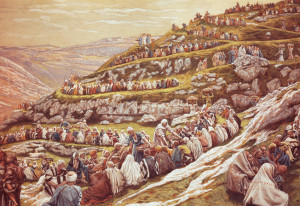 This is the third installment in our series on undesigned coincidences in the gospels, based on a presentation by Dr. Tim McGrew. For an introduction to undesigned coincidences and this series, go here.
This is the third installment in our series on undesigned coincidences in the gospels, based on a presentation by Dr. Tim McGrew. For an introduction to undesigned coincidences and this series, go here.
Feeding of the 5,000
In this article, we offer you a two-for-one deal. We’ll consider two undesigned coincidences in Mark 6:30-40 and John 6:4.
These passages deal with a famous miracle story, in which Jesus fed 5,000 people with only five loaves of bread and two fish. Let’s t’s start with the passage in Mark:
30 The apostles gathered around Jesus and reported to him all they had done and taught. 31 Then, because so many people were coming and going that they did not even have a chance to eat, he said to them, “Come with me by yourselves to a quiet place and get some rest.”
32 So they went away by themselves in a boat to a solitary place. 33 But many who saw them leaving recognized them and ran on foot from all the towns and got there ahead of them. 34 When Jesus landed and saw a large crowd, he had compassion on them, because they were like sheep without a shepherd. So he began teaching them many things.
35 By this time it was late in the day, so his disciples came to him. “This is a remote place,” they said, “and it’s already very late. 36 Send the people away so that they can go to the surrounding countryside and villages and buy themselves something to eat.”
37 But he answered, “You give them something to eat.”
They said to him, “That would take more than half a year’s wages! Are we to go and spend that much on bread and give it to them to eat?”
38 “How many loaves do you have?” he asked. “Go and see.”
When they found out, they said, “Five—and two fish.”
39 Then Jesus directed them to have all the people sit down in groups on the green grass. 40 So they sat down in groups of hundreds and fifties…
In reading this passage, two questions come to mind:
- Why were so many people “coming and going”? What was causing all the crowds?
- What’s this business about “green grass” in the Holy Land? Isn’t the area a desert?
Mark doesn’t provide the answers, but interlocking data in John’s gospel does. Let’s read the relevant part of John’s account, paying special attention to John 6:4:
Some time after this, Jesus crossed to the far shore of the Sea of Galilee (that is, the Sea of Tiberias), 2 and a great crowd of people followed him because they saw the signs he had performed by healing the sick. 3 Then Jesus went up on a mountainside and sat down with his disciples. 4 The Jewish Passover Festival was near.
John tells us that the Passover Festival was near. Well, it appears that this little nugget of information clears up both questions:
- The crowds were so large because of the annual Passover festival, which drew more than 2.5 million pilgrims to Jerusalem each year, according to Josephus.1 Likely, that number is exaggerated 2, but it does make a point. There were a lot of people headed for Jerusalem, and the roads would have been thronged with travelers.
- Passover occurs during the growing season in that part of the world, which explains the green grass.
In this case, John explains Mark. It’s one more undesigned coincidence that demonstrates the interlocking nature of the gospels. It further supports the ideas that these are independent accounts, and strengthens the case for historical accuracy. Until next time…
Notes:
- Josephus, The Jewish War, 9.3 422-427
- “No one believes the largest of these figures,” writes E. P. Sanders inJudaism: Practice and Belief 63 BCE – 66 CE (p. 126). Sanders estimates the actual number of attendees to be 300,000 to 500,000. Still, that’s an extremely large number of people packing roadways.
